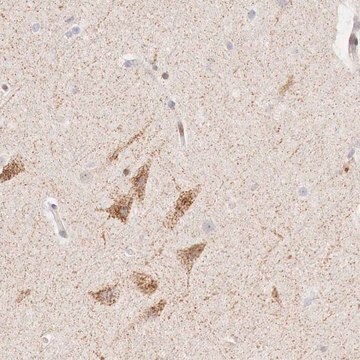推薦產品
生物源
rabbit
品質等級
共軛
unconjugated
抗體表格
affinity isolated antibody
抗體產品種類
primary antibodies
無性繁殖
polyclonal
形狀
lyophilized powder
物種活性
human, mouse, rat
技術
western blot: 1:200 using rat kidney membranes
UniProt登錄號
運輸包裝
dry ice
儲存溫度
−20°C
目標翻譯後修改
unmodified
基因資訊
human ... CLCN5(1184)
mouse ... Clcn5(12728)
rat ... Clcn5(25749)
免疫原
peptide corresponding to amino acid residues 401-415 of rat CLC5. Mouse sequence is identical; human sequence is 14/15 residues identical.
應用
Anti-Chloride Channel CLC-5 (Clcn5) antibody produced in rabbit is suitable for western blotting at a dilution of 1:200 using rat kidney membranes.
生化/生理作用
H(+)/Cl(-) exchange transporter 5 is a protein encoded by the CLCN5 gene in humans. It encodes a member of the CLC gene family of chloride ion channels and ion transporters. CLCN5 is highly expressed in endosomes of proximal tubule cells and is essential for endocytosis. Mutations in CLCN5 causes Dent′s disease leading to renal failure. It is also involved in low-molecular-weight proteinuria, hypercalciuria, nephrolithiasis and renal failure. Majority of these disease-causing mutations in ClC-5 are misprocessed and retained in the ER (endoplasmic reticulum) and may alter intramolecular interactions within the full-length ClC-5 protein. CLC-5 plays a crucial role in the process of endocytosis in the proximal tubule of the kidney and mutations that alter protein function are the cause of Dent′s disease. It may act as an electrically shunting Cl- channel in early endosomes, facilitating intraluminal acidification.
外觀
Lyophilized from phosphate buffered saline containing, pH 7.4, 1% BSA and 0.05% sodium azide
免責聲明
Unless otherwise stated in our catalog or other company documentation accompanying the product(s), our products are intended for research use only and are not to be used for any other purpose, which includes but is not limited to, unauthorized commercial uses, in vitro diagnostic uses, ex vivo or in vivo therapeutic uses or any type of consumption or application to humans or animals.
未找到適合的產品?
試用我們的產品選擇工具.
儲存類別代碼
11 - Combustible Solids
水污染物質分類(WGK)
WGK 2
Silvia De Stefano et al.
The Journal of physiology, 591(23), 5879-5893 (2013-10-09)
ClC-5 is a 2Cl(-)/1H(+) antiporter highly expressed in endosomes of proximal tubule cells. It is essential for endocytosis and mutations in ClC-5 cause Dent's disease, potentially leading to renal failure. However, the physiological role of ClC-5 is still unclear. One
Miriam F Figueira et al.
Physiological reports, 5(13) (2017-07-06)
Diabetic nephropathy (DN) occurs in around 40% of those with diabetes. Proteinuria is the main characteristic of DN and develops as a result of increased permeability of the glomerulus capillary wall and/or decreased proximal tubule endocytosis. The goal of this
Hengli Zhang et al.
Clinical & experimental optometry, 94(6), 528-535 (2011-09-08)
Experimental evidence has shown that myopic and hyperopic optical defocus induces thickening and thinning of the choroids, respectively, moving the retina forward and backward toward the plane of focus; however, the underlying mechanism of this phenomenon remains elusive. It has
Jonathan D Lippiat et al.
Frontiers in physiology, 3, 449-449 (2012-12-12)
CLC-5 plays a critical role in the process of endocytosis in the proximal tubule of the kidney and mutations that alter protein function are the cause of Dent's I disease. In this X-linked disorder impaired reabsorption results in the wasting
Christina D'Antonio et al.
The Biochemical journal, 452(3), 391-400 (2013-04-10)
Mutations in the CLCN5 (chloride channel, voltage-sensitive 5) gene cause Dent's disease because they reduce the functional expression of the ClC-5 chloride/proton transporter in the recycling endosomes of proximal tubule epithelial cells. The majority (60%) of these disease-causing mutations in
Active Filters
我們的科學家團隊在所有研究領域都有豐富的經驗,包括生命科學、材料科學、化學合成、色譜、分析等.
聯絡技術服務







